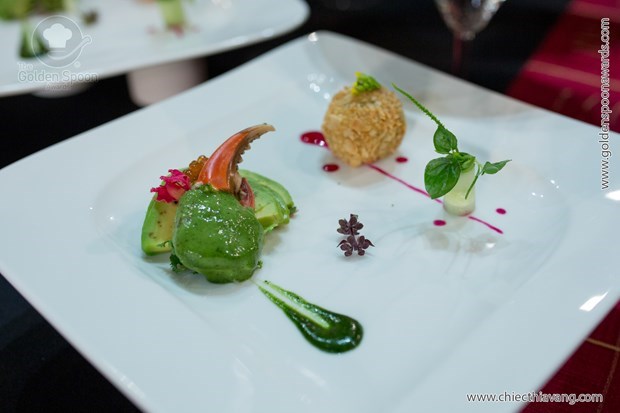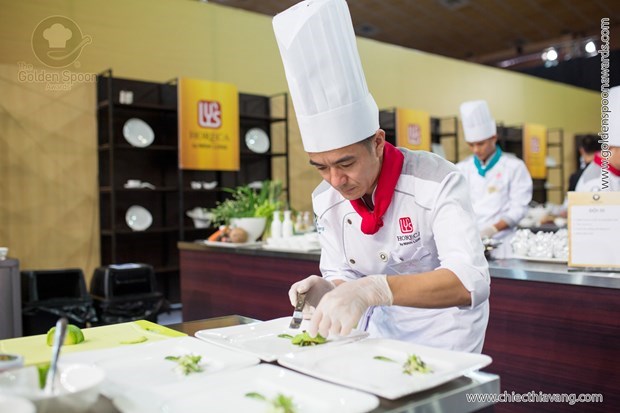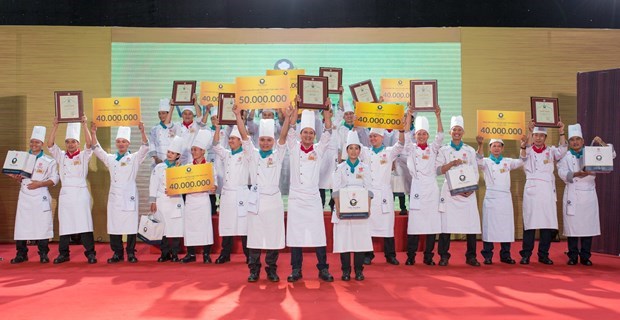What are reasons? Southeastern region has focused on
industries, services, and it is one of key economic regions. It has no unique
or special products but in return, chefs there were the earliest integrative
group and they have had the most chances to interact different cultures.
Therefore, their culinary styles are so diverse.

Salad of avocado, Thun Mun leave, crabmeat, and salmon eggs, server with vinegar-leaf sauce - Paste of shrimp, Huong snail meat, and pepper leaves in Chay-fruit sauce, served with vegetables.
Cuisine in land of
ports
Historically, southeastern area, or briefly “the east”,
is the interference among different cultures, such as Cham, Khmer, and partly
Highlands.
Deep and salted seashores from Ninh Thuan to Binh
Thuan province are advantages to produce and supply high-quality seafood and
marine products. In addition are natural bays and ports, which were exploited
by the French, through Dong Nai and Ba Ria – Vung Tau provinces, that support
international economics and are ready for the formation of national key economic
quadrangle.
Because of those characteristics, the eastern cuisine
is widely opened. Businessmen have come to trade and also brought their
cultural and culinary feature from numerous countries. Gradually, exotic
feature has been localized and became parts of this region.
Therefore, Palace Vung Tau team decided to create a
diverse menu with all healthy herbal dishes.

Chef Pham Van Dai was about to garnish his final dish.
Their regional yet exotic ingredients attracted all
audiences, like Thun Mun leaves, Pagoda flowers (Styphnolobium
japonicum), Thi fruits (Diospyros
decandra), and bird
chili’s tips. The most noticeable dish in the menu was Stewed chicken with deer velvet, nutmeg, papaya seeds, served with
steamed rice and lotus seeds in which papaya seed is very familiar but
rarely used in cooking. Audiences were so curious when first time seeing deer
velvets, which was soaked in ice water before being processed. Recently,
farming deer to collect velvets is a common profession in this zone. Velvets
are young antlers from mature male deer.
In
the end of summer every year, antlers shed and re-grow next spring. Young
antlers, which contain lots of blood vessels, are soft and fluffy as a sheet of
velvet.
Velvets
have (or have not) ramified, called saddle velvets since their shape is like a
saddle with one short hand and one longer hand.
Velvets
must be immediately processed after collected or they will be rotten. Chemical
component analysis shows that velvets contain calcium carbonate, calcium
phosphate, colloidal, protein, hormones (testosterone, pantocrine), and more
than 17 types of amino acid.
Modern
Western medicine believes that deer antler can increase muscle strength, help
refreshing minds and healing, stimulate eating and sleeping habits, increase gastrointestinal
motility but strong doses can cause low blood pressure, palpitation, muscle
twitching, convulsion, or blood clot.
In
the other hand, Vietnamese traditional medicine has noticed that velvets are so
supportive to blood, bones, and sexual ability.
For
centuries, traditional Chinese and Japanese healers have used velvets to
support the whole human body.

Southern teams going to the final round.
And features of oceans
Once
there was a commentator talking on Culture show of CNN about Vietnamese cuisine
“Vietnamese coastal line stretches from
the North to the South, crossing different climate zones and different soil so
that every coastal region has its own tastes of seafood, even some places have
unique specialties that we can’t find anywhere else. Very interesting!”
In
The Golden Spoon 2016 semi-final round, young chefs from the southeast – Sea
Links City company – had proved it by its Golden Dish menu.
They
carried featured products of the harsh Binh Thuan province, which were coffer
fish (Ostraciidae), big sage
(Lantana camara), young sponge gourd, and sea-pangolin (abalone-like with a
8-layer scale as a pangolin).
Sea-pangolin was a noticeable
ingredient, which was stuffed in wonton and cooked with Kim Cang root and
served with crunchy melon. Kim Cang root was to sweeten wonton soup. However,
it can be eaten raw with a taste like jicama or mixed with pickled melon to
wake the tongue up.
Another remarkable point at The
Golden Spoon 2016 semi-final round that international audiences were very
interested in was cassava cake. Even though cassava cake is just a casual
street food, it came into menus of two teams that won the 1st prize
in preliminary.
While Thang Loi 1 Restaurant and
Wedding center made an old-fashioned plain cassava cake, Palace Vung Tau
created a new taste by stuffing Thi fruit inside cassava cake.
One of my friends who has worked for
an international hotel & restaurant management group said, “Vietnamese cassava needs to be appropriately
exploited. They are able to live in the harshest soil as coastal sand areas,
they do not need to be taken care of, and they are ingredients for great
cuisine.
Vietnamese rarely notice that science has proved that
cassava flour does not contain gluten, an element causes severe allergy in the
US. Therefore, cassava will be potential supply. I appreciate that The Golden
Spoon has brought cassava cake onto 5-star party tables.”
Properly The Golden Spoon contest
could not expect that it has honored such an interesting future food.
By Kien Chinh/TTTG